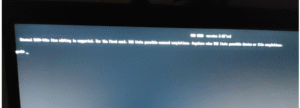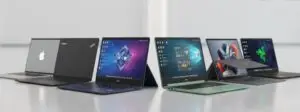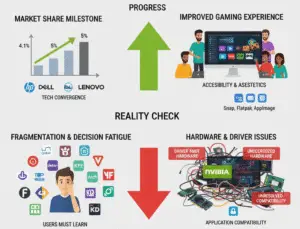
Deepfake Scams in 2025: How to Spot and Stop Them
Introduction
Imagine getting a video call from your boss asking you to transfer company funds—only to later realize it wasn’t really them. Or receiving a message from a “family member” in distress, pleading for money, but their voice sounds just a little… off.
Welcome to the world of deepfake scams—one of the most dangerous cyber threats in 2025.
Deepfake technology uses artificial intelligence (AI) to create fake videos, audio, and images that look and sound real. Scammers use this tech to trick people into handing over money, sensitive data, or access to accounts.
In this guide, we’ll explain:



Let’s dive in.
What Are Deepfake Scams?
A deepfake scam is when criminals use AI-generated fake media (videos, voice calls, or images) to deceive people. These scams are becoming more common, more realistic, and harder to detect in 2025.
Types of Deepfake Scams
| Type | How It Works | Example |
|---|---|---|
| Fake CEO Fraud | Scammers impersonate a company executive to trick employees into wiring money. | A finance worker transferred $25M after a deepfake video call with his “CFO.” |
| Fake Kidnapping Calls | AI clones a loved one’s voice, claiming they’re in danger and need ransom money. | A mother sent $15K after hearing her “daughter” scream for help—but it was fake. |
| Romance Scams | Scammers create fake profiles with AI-generated photos/videos to manipulate victims. | A man lost $50K to a woman who didn’t exist—her videos were all deepfakes. |
| Political Disinformation | Fake videos of politicians spread false statements, causing panic or influencing elections. | A fake video of a leader declaring war went viral, causing stock market chaos. |
How Do Deepfake Scams Work?
Deepfake scams follow a simple pattern:
Scammers Gather Data
They collect public videos, photos, or voice clips (from social media, interviews, etc.).
Some even use voice recordings from hacked devices.
AI Creates the Fake Content
Tools like DeepFaceLab, Wav2Lip, or ElevenLabs generate realistic fakes.
The scammer tweaks the AI to match tone, facial expressions, and voice patterns.
The Scam Is Executed
The fake media is sent via video calls, emails, or social media.
Urgency is created (“Transfer money NOW!” or “I’m in trouble, help!”).
Victims Fall for the Trap
Because it looks/sounds real, people act fast without verifying.
Real-Life Deepfake Scam Examples (2024-2025)
1. The $25 Million CEO Fraud (Hong Kong, 2024)
A finance employee received a video call from his “CFO” instructing him to transfer $25 million for a secret acquisition. The video looked real—same face, same voice. Only later did the company realize it was a deepfake.
Lesson: Always double-check unusual requests via another communication method (e.g., phone call).
2. The Fake Kidnapping Hoax (Texas, 2025)
A mother got a call from her “daughter” screaming, “Mom, they’ve got me! Send $15,000 or they’ll hurt me!” The voice was identical—but it was AI-generated. Police later confirmed her daughter was safe at school.
Lesson: Ask a security question only the real person would know (e.g., “What was our first pet’s name?”).
3. The AI-Generated Romance Scammer (UK, 2024)
A man fell in love with a woman on a dating app. They video-called, and she seemed real. After he sent $50,000 for her “medical bills,” he discovered her videos were deepfakes.
Lesson: Reverse-image search profile pictures to check for duplicates.
Who Is Most at Risk?
| Target Group | Why They’re Vulnerable | Common Scams |
|---|---|---|
| Businesses | Employees trust executives. | Fake CEO money transfers. |
| Elderly People | Less tech-savvy, more trusting. | Fake grandkid emergency scams. |
| Social Media Users | Lots of public photos/videos. | Fake romance/friend scams. |
| Celebrities/Influencers | Faces/voices are easy to copy. | Fake endorsements or scams. |
How to Spot a Deepfake Scam

Blurry edges around faces
Unnatural eye movements
Robotic voice tones

Is the person acting strangely? (e.g., a CEO asking for urgent money)
Does their mouth not sync perfectly with speech?

Call the person directly on a known number.
Ask a personal question only they’d know.

Microsoft Video Authenticator
Deepware Scanner
Google Reverse Image Search
How to Protect Yourself in 2025
For Individuals:



For Businesses:



For Social Media Users:


The Future of Deepfake Scams (Beyond 2025)
AI Will Get Better → Fakes will be nearly undetectable.
Voice Cloning Attacks → Scammers will mimic anyone in seconds.
Legal Crackdowns → Governments may regulate deepfake tools.
Staying cautious is the best defense.
Conclusion
Deepfake scams in 2025 are more advanced, more convincing, and more dangerous. But by knowing how they work, spotting red flags, and verifying suspicious requests, you can avoid becoming a victim.
Deepfake Scams: Detection, Response, and Legal Landscape (2025)
Can Deepfake Videos Be Detected? (Yes, But It’s Getting Harder)
Deepfake detection is an ongoing arms race between scammers and security experts. Here’s what you need to know about detecting them in 2025:
Current Detection Methods
-
AI-Powered Detection Tools
-
Microsoft Video Authenticator: Analyzes facial movements and blood flow patterns
-
Deepware Scanner: Checks for digital artifacts in videos
-
Intel’s FakeCatcher: Detects heartbeat signatures in pixels (real faces show subtle pulse)
-
-
Manual Detection Techniques
-
Unnatural Eye Movements: Deepfakes often blink unnaturally or avoid eye contact
-
Lip Sync Errors: Words don’t perfectly match mouth movements
-
Skin Texture: Looks too perfect or has inconsistent lighting
-
Hair Details: Individual strands may appear merged or fuzzy
-
Background Glitches: Objects may warp slightly around the face
-
-
Audio Detection
-
Adobe’s VoCo can identify AI-generated voice patterns
-
Unnatural pauses or robotic tones in speech
-
Voice cloning often misses emotional nuances
-
Example: In 2024, a bank employee spotted a deepfake CEO because his tie knot kept flickering unnaturally during a video call.
Why Detection is Getting Harder
-
Generative AI Improvements: New models like OpenAI’s Sora create near-perfect videos
-
Adversarial Training: Scammers now train AI to bypass detection tools
-
Hybrid Fakes: Combining real footage with AI elements makes detection tougher
Best Practice: Use multiple verification methods – don’t rely solely on detection tools.
What Should I Do If I’ve Been Scammed?
Immediate Actions
-
Document Everything
-
Save all communications (emails, messages, call logs)
-
Take screenshots of video/audio interactions
-
Note transaction details (amounts, account numbers)
-
-
Financial Damage Control
-
Contact your bank/financial institution immediately
-
File a fraud report (most banks have 24/7 hotlines)
-
Freeze affected accounts and credit reports
-
-
Tech Security Steps
-
Change all passwords (especially email and financial accounts)
-
Enable two-factor authentication everywhere
-
Scan devices for malware (deepfake scams often involve spyware)
-
Reporting the Scam
-
Law Enforcement
-
Local police (get a case number)
-
FBI’s IC3 (Internet Crime Complaint Center)
-
FTC (Federal Trade Commission)
-
-
Specialized Organizations
-
Deepfake-specific hotlines are emerging in 2025
-
Your state’s Attorney General office
-
-
Platform Reporting
-
If scam occurred on social media, report to the platform
-
For business scams, notify corporate security teams
-
Example: A 2024 victim recovered 60% of stolen funds by acting within 2 hours and providing detailed transaction evidence.
Emotional Recovery
-
Contact victim support groups (like Identity Theft Resource Center)
-
Consider professional counseling – these scams cause significant trauma
-
Educate family/friends to prevent secondary scams
Are There Laws Against Deepfake Scams?
Current Legal Landscape (2025)
-
United States
-
DEEPFAKES Accountability Act (Federal, proposed 2024)
-
*California’s AB-730*: Bans political deepfakes within 60 days of elections
-
Texas Penal Code § 33.021: Criminalizes harmful deepfake creation
-
-
European Union
-
AI Act (2025 implementation): Requires watermarking of AI-generated content
-
GDPR Amendments: Deepfakes using personal data face heavy fines
-
-
Asia-Pacific
-
China’s Deepfake Regulations: Mandates clear labeling of synthetic media
-
South Korea’s AI Ethics Act: Jail time for malicious deepfake creators
-
Legal Challenges
-
Jurisdiction Issues: Scammers often operate across borders
-
Free Speech Debates: Balancing regulation with creative/parody uses
-
Rapid Technology Changes: Laws struggle to keep pace with AI advances
Successful Prosecutions
-
2024: First U.S. conviction for deepfake-enabled fraud (7-year sentence)
-
2023: German court ordered €450,000 compensation in a CEO fraud case
-
2025: Interpol’s first international deepfake scam takedown operation
Future Trends: Expect more aggressive legislation as deepfake scams increase, with potential for:
-
Mandatory AI content watermarks
-
Real-time deepfake detection requirements for platforms
-
Stiffer penalties for malicious use
Proactive Protection Strategies
For Individuals
-
Set up family safe words for emergency verification
-
Limit social media posts that reveal your voice/face patterns
-
Use signal-based authentication apps for sensitive communications
For Businesses
-
Implement multi-person approval for financial transactions
-
Conduct regular deepfake awareness training
-
Develop verification protocols for executive communications
Technological Solutions
-
Blockchain-based media authentication systems
-
Biometric verification tools (like vein pattern recognition)
-
AI watermarking standards for legitimate content
Remember: In 2025, skepticism is a virtue. Always verify unusual requests through multiple channels before acting. The few minutes spent verifying could prevent devastating losses.




